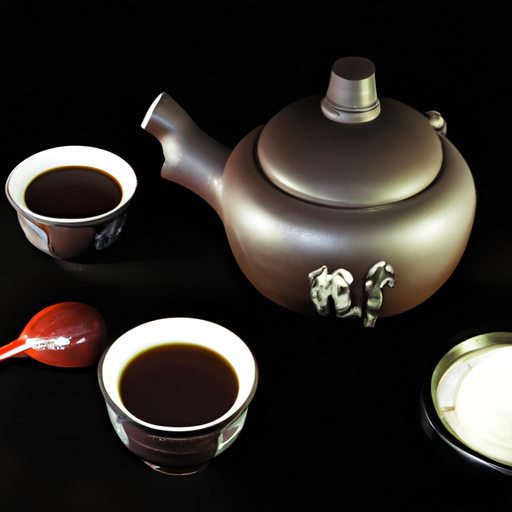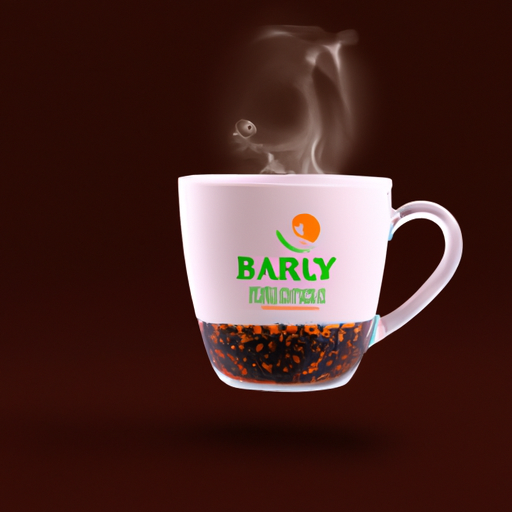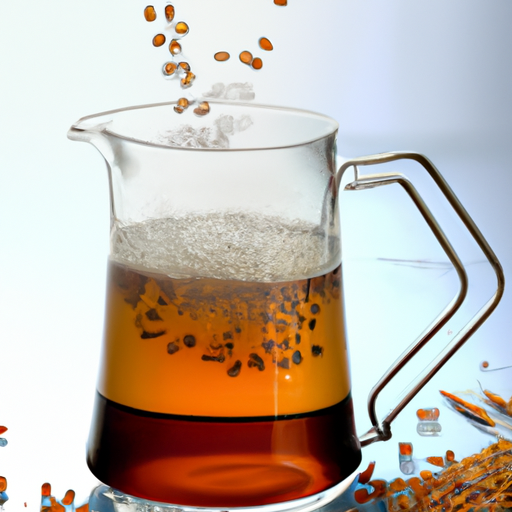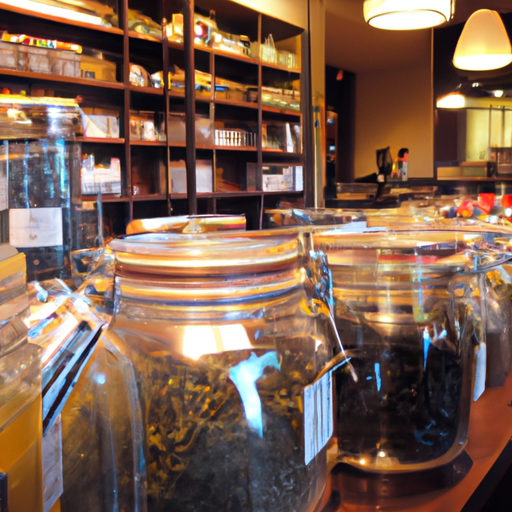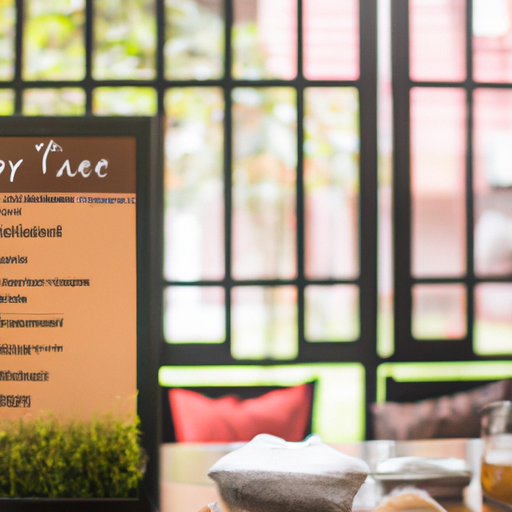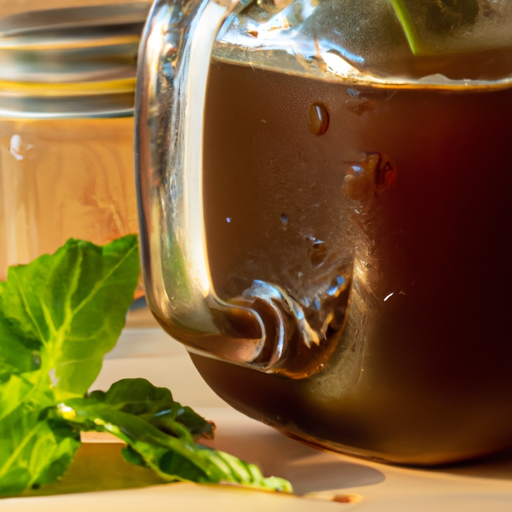Korean cuisine has always captivated me, and among my top picks for drinks is the Korean barley tea, widely known as boricha. This quintessential tea holds a special place in Korean homes and is versatile enough to be served warm or chilled, offering a delightful beverage option throughout the year.
Boricha has been consumed in Korea for centuries, and it is believed to have originated in the Goryeo Dynasty (918-1392). It was traditionally made by roasting barley and then steeping it in water, and it was often used as a substitute for water because it was believed to have health benefits.
In modern times, boricha is still a popular drink in Korea, and it is often served as a refreshing beverage with meals or as a way to cool down during the hot summer months. As a lover of Korean cuisine, I am excited to explore the many facets of this delicious and nutritious drink.
Brief History and Cultural Significance of Boricha
Let’s take a sip of Boricha, a refreshing Korean barley tea that’s been enjoyed for centuries and holds significant cultural value in Korea.
Boricha, also known as barley tea, is one of the most popular non-alcoholic beverages consumed in Korea. Its origin can be traced back to the Goryeo Dynasty, where it was served to the king and his courtiers.
Apart from being a refreshing drink, Boricha also plays a vital role in traditional ceremonies. It’s often served during ancestral rites, weddings, and other important events. The drink’s mild taste and aroma make it a perfect accompaniment to the traditional Korean meal, as it helps to cleanse the palate and aids in digestion.
Boricha’s symbolism in Korean art is another essential aspect of its cultural significance. The drink is often depicted in traditional paintings, calligraphy, and other forms of art, symbolizing the importance of simplicity, purity, and harmony in Korean culture. The drink’s light golden color and delicate aroma have also inspired many poets and writers throughout Korean history.
As you can see, Boricha has a rich cultural history and holds a special place in the hearts of Koreans. Now, let me show you how to make Korean barley tea.
How to Make Korean Barley Tea
So, if you want to make your own Korean barley tea, here’s what you’ll need and how to make it!
First, you’ll need barley (of course!), water, and a tea strainer. Start by rinsing the barley, then toasting it in a dry pan until it turns golden brown.
Then, add the toasted barley to boiling water and let it steep for about five minutes before straining it.
Required Ingredients
To make Korean barley tea, you’ll need water, barley, and a tea bag. Barley tea is a popular beverage in Korea, enjoyed for its refreshing taste and numerous health benefits. Barley is known to aid digestion, lower cholesterol, and promote weight loss. This makes Korean barley tea an excellent choice for those looking to improve their overall health.
There are several recipe variations for Korean barley tea, but the basic ingredients remain the same. Some people like to toast the barley before brewing, while others prefer a sweeter version with added honey or brown sugar. Regardless of the recipe variation, the key is to steep the barley in hot water for at least 10 minutes to allow the flavors to infuse.
This will result in a delicious and healthy drink that can be enjoyed hot or cold.
Moving on to the next section, let me guide you through the step-by-step instructions on how to make Korean barley tea.
Step-by-Step Instructions
First, you’ll need to gather the ingredients and prepare to brew a delicious and healthy beverage that’s sure to satisfy your taste buds. To make Korean barley tea, you’ll need barley, water, and a tea bag.
Start by rinsing the barley in cold water to remove any dirt or debris. Then, add the barley to a pot with water and bring it to a boil. Once it’s boiling, reduce the heat and let it simmer for about 20 minutes.
After that, turn off the heat and let it cool for a few minutes before straining the barley and pouring the tea into a cup. You can add a tea bag for extra flavor, or enjoy it plain.
Boiling time may vary depending on the amount of barley and water used, but generally, 20 minutes is enough to extract the flavor and nutrients from the barley.
As for serving suggestions, Korean barley tea can be enjoyed hot or cold, and it’s a great alternative to sugary drinks. You can add honey or lemon for a sweeter taste, or drink it plain for a refreshing and healthy beverage.
Now that you know how to make Korean barley tea, let’s move on to the nutritional value and health benefits of boricha.
Nutritional Value and Health Benefits of Boricha
Boricha, a popular Korean barley tea, is not only delicious but also packed with health benefits. This tea has been enjoyed by Koreans for centuries, and it’s easy to see why. Not only is it a refreshing drink, but it also provides many health benefits such as improving digestion and reducing inflammation.
One of the main health benefits of boricha is its ability to improve digestion. This tea contains fiber which helps to promote healthy bowel movements and prevent constipation. It also contains enzymes that help to break down food and improve the absorption of nutrients. Additionally, boricha has been shown to reduce inflammation in the digestive tract, which can help to alleviate symptoms of conditions such as irritable bowel syndrome (IBS).
Another benefit of boricha is its ability to promote hydration. This tea is a great way to stay hydrated throughout the day, especially during hot summer months. It’s also a great alternative to sugary drinks, which can be detrimental to your health. To give you a better idea of the nutritional value of boricha, here’s a table that breaks down its key components:
| Nutrient | Amount per 100g |
|---|---|
| Calories | 0 |
| Protein | 0g |
| Fat | 0g |
| Carbohydrates | 0.3g |
Boricha is a delicious and healthy drink that has been enjoyed by Koreans for centuries. Its health benefits, such as improving digestion and reducing inflammation, make it a great addition to any diet. Plus, its low calorie and sugar content make it a great alternative to sugary drinks. In the next section, we’ll explore how boricha is used in Korean cuisine.
Boricha in Korean Cuisine
You may be surprised to learn that boricha isn’t only consumed as a beverage, but it’s also used in various Korean dishes to add a unique flavor and nutritional value. Brewing boricha involves boiling roasted barley grains in water, resulting in a slightly nutty and toasty taste. This makes it a great ingredient to use in savory dishes that need a subtle hint of warmth and depth.
Here are some examples of how boricha is used in Korean cuisine:
- Boricha is added to soups and stews as a base or to enhance the umami flavor.
- Boricha is used as a marinade for meats, giving them a sweet and earthy taste.
- Boricha is mixed with rice to make a healthier version of rice porridge, known as boribap.
- Boricha is even used in desserts, such as in a refreshing sorbet or as a flavoring for ice cream.
Not only does boricha add a unique taste to dishes, but it’s also a healthier alternative to other cooking liquids like oil or broth. With its low calorie count and high fiber content, boricha makes for a nutritious ingredient that can benefit your overall health.
Moving on to different varieties of Korean tea, let’s explore the various flavors and benefits they offer.
Different Varieties of Korean Tea
I absolutely love exploring different varieties of Korean tea, and there are three types that I find particularly fascinating: green tea, black tea, and herbal tea.
Green tea is a staple in Korean culture, and it’s known for its refreshing taste and numerous health benefits.
Black tea, on the other hand, is a relatively new addition to Korean tea culture, but it’s quickly gaining popularity for its rich flavor and unique aroma.
Finally, herbal tea is a diverse category that includes everything from traditional Korean medicinal teas to modern blends that incorporate exotic ingredients from around the world.
Green Tea
Sipping on a warm cup of green tea will make you feel rejuvenated and refreshed, perfect for a midday pick-me-up. Green tea has been known for its health benefits for centuries, and it’s no wonder why it’s still a popular drink to this day.
Not only does it contain antioxidants that help fight off diseases and infections, but it also aids in weight loss by boosting your metabolism. To get the most out of your green tea, it’s important to know the best ways to brew it.
Start by using fresh, filtered water and bring it to a boil. Let it cool for a few minutes before pouring it over your tea leaves. Steep for about 2-3 minutes and enjoy! Adding a touch of honey or lemon can also enhance the flavor.
But enough about green tea, let’s move on to black tea. Did you know that black tea actually comes from the same plant as green tea, but it’s processed differently?
Black Tea
When you’re in need of a caffeine boost, black tea is a great option that’s easy to find at your local grocery store. Not only does it provide a quick pick-me-up, but it also offers a range of health benefits. According to studies, black tea contains antioxidants that can help improve heart health, lower blood pressure, and reduce the risk of stroke.
To get the most out of your cup of black tea, it’s important to use the right brewing techniques. Generally, black tea should be brewed in water that’s just below boiling point for 3-5 minutes. This will ensure that the tea releases its full flavor and benefits. Additionally, adding a splash of milk or a dash of honey can enhance the taste and add extra health benefits. So, next time you’re looking for a caffeine fix, reach for a cup of black tea and savor the rich taste and benefits it provides.
Moving on to the next section about herbal tea, there are many different types to explore and discover.
Herbal Tea
As much as I love black tea, I also enjoy exploring different kinds of herbal teas. They’re often fragrant and refreshing, and have various health benefits that I can enjoy while sipping on a warm cup of tea.
There are many types of herbal tea out there, each with its unique flavor and aroma, and I find it exciting to try new ones whenever I can. One of my favorite herbal teas is Korean barley tea. It’s a popular beverage in Korea, where it’s known as ‘boricha.’
Made from roasted barley kernels, this tea has a nutty, earthy flavor that I find very satisfying. Not only is it delicious, but it also has several health benefits. It’s said to aid digestion, reduce stress, and improve blood circulation, among other things.
Brewing this tea is easy, too. All you need to do is boil water and add the barley tea bags or loose leaves, and let it steep for a few minutes. It can be enjoyed hot or cold, depending on your preference.
Now that you know how to brew Korean barley tea and its health benefits, I bet you’re wondering where you can get your hands on some. Well, the good news is that it’s widely available in Korean grocery stores and online. You can also try making it at home with barley grains that you can find in health food stores.
So go ahead and give it a try, and see for yourself why it’s such a beloved beverage in Korea.
Where to Buy Korean Barley Tea
If you’re looking for a refreshing and healthy beverage, you can easily find Korean barley tea at your local Korean grocery store or online. Many people enjoy the taste of this tea, which is made from roasted barley and has a slightly nutty flavor. It’s a great alternative to sugary drinks and is often served both hot and cold.
For those who prefer to shop online, there are many options available. Several websites offer Korean barley tea, and you can choose from a variety of brands and flavors. You can also find it on popular e-commerce sites like Amazon and eBay. Just be sure to read reviews and check the shipping times to ensure that you get the best deal.
If you prefer to shop in person, you can find Korean barley tea at most Korean grocery stores. Look for it in the tea section, where you’ll find a variety of other herbal teas as well. Some stores may offer samples so you can try it before you buy it.
So, whether you’re a fan of online shopping or prefer to get out and explore your local stores, there are plenty of options for finding Korean barley tea.
Korean barley tea is just one of the many beverages enjoyed in Korean culture. Another popular drink is boricha, which is made from roasted barley and enjoyed both hot and cold. It’s often served with meals and is known for its mild flavor and health benefits. So, if you’re interested in learning more about Korean beverages, be sure to explore the rich history and culture behind these delicious drinks.
Boricha in Korean Culture
Boricha, a popular drink in Korea, is often enjoyed with meals and has a mild flavor with health benefits. It is made from roasted barley and is caffeine-free, making it a great alternative to coffee or tea. In Korean culture, boricha is more than just a beverage; it is a symbol of hospitality and respect.
Boricha customs and traditions are deeply ingrained in Korean culture. It is often served to guests as a sign of welcome and is also used in traditional Korean ceremonies. In some regions, it is believed that drinking boricha can help with digestion and improve overall health. It is also a popular drink during the summer months as it is served cold and can help cool down the body.
In modern society, boricha is still a beloved drink in Korea. It can be found in most Korean restaurants and is also available in supermarkets. Many people still follow the customs and traditions associated with boricha, such as serving it to guests or drinking it during ceremonies. Despite the rise of coffee and other trendy beverages, boricha remains a staple in Korean culture and is enjoyed by people of all ages.
Boricha in Modern Society
As I mentioned before, boricha has been a staple in Korean culture for centuries. However, in modern society, this tea has gained even more popularity due to its numerous health benefits.
First and foremost, boricha is an excellent source of hydration, which is essential for maintaining good health. Additionally, this tea is rich in antioxidants, which can help reduce inflammation and fight against diseases such as cancer and heart disease.
Furthermore, many people have turned to boricha for its mental health benefits. This tea has been shown to have a calming effect on the body, which can help reduce stress and anxiety. In a world where mental health is becoming increasingly important, boricha can be a great addition to a self-care routine.
Boricha can also aid in digestion and improve gut health. It is a great alternative to sugary drinks and can aid in weight loss. Some studies suggest that boricha can help regulate blood sugar levels in people with diabetes.
As you can see, boricha is more than just a delicious and refreshing tea. It offers a plethora of health benefits that can improve both physical and mental wellness.
In the next section, we’ll explore how boricha has spread beyond Korea and is enjoyed by people around the world.
Boricha around the World
Interestingly enough, boricha has made its way around the world and is now enjoyed by people in various countries. This Korean barley tea has become popular globally due to its unique flavor and health benefits. In fact, it is now readily available in many Asian grocery stores and online shops.
As boricha became more popular, it also underwent cultural adaptations in different countries. For example, in Japan, it is called mugicha and is often served cold. In China, it is known as damai cha and is sometimes served with sugar or honey. These cultural adaptations demonstrate the versatility of boricha and how it can be adapted to suit the taste preferences of different cultures.
To further illustrate the global popularity of boricha, here is a table that shows the different names of barley tea in various countries:
| Country | Name of Barley Tea |
|---|---|
| Korea | Boricha |
| Japan | Mugicha |
| China | Damai Cha |
| Taiwan | Maicha |
As we can see, barley tea has become a staple in many Asian cultures. Its global popularity is a testament to its delicious flavor and health benefits. And as it continues to be adapted to suit different cultures, it will undoubtedly remain a beloved beverage for years to come.
Frequently Asked Questions
What are some common flavor profiles of Korean barley tea?
When it comes to Korean barley tea, there are a few common flavor profiles that come to mind. Sweet and nutty, with a slightly earthy and toasty undertone, are the most prevalent. It’s a comforting and soothing drink that’s perfect for any time of day.
But it’s not just the taste that makes this tea so special. Korean barley tea has a rich cultural significance and is often served as a way to welcome guests into the home. It’s also known for its health benefits, such as aiding digestion and boosting the immune system.
Overall, Korean barley tea is a delicious and meaningful beverage that’s worth trying.
How does the brewing process for Korean barley tea differ from other types of tea?
When it comes to brewing Korean barley tea, it’s important to note that the process differs from that of other types of tea.
Unlike green tea, which is steeped in hot water for just a few minutes, barley tea requires a longer brewing time to really bring out its flavor.
The most common method involves roasting the barley grains first, then boiling them in water for about 20-30 minutes.
The resulting tea has a nutty, toasty flavor that’s both refreshing and comforting.
But what sets Korean barley tea apart from other teas is its numerous health benefits.
Not only is it rich in antioxidants, but it’s also said to aid digestion, boost the immune system, and even lower cholesterol levels.
So if you’re looking for a delicious and healthy beverage that’s easy to make, give Korean barley tea a try!
Are there any traditional ceremonies or rituals associated with the consumption of Korean barley tea?
When it comes to Korean barley tea, there are certainly some cultural practices and traditional significance associated with its consumption.
For example, it’s often served to guests as a gesture of hospitality, and in some cases, it’s even used in traditional Korean tea ceremonies.
Additionally, there are many health benefits and nutritional value associated with drinking Korean barley tea. It’s believed to promote digestion, reduce inflammation, and even help regulate blood sugar levels.
Overall, whether you’re interested in the cultural significance or the health benefits, Korean barley tea is definitely worth trying.
Can Korean barley tea be used in cooking or baking?
Korean barley tea can definitely be used in cooking or baking, and there are a variety of recipes that incorporate this delicious and nutritious beverage.
One popular option is to use it as a base for marinades or sauces, as the nutty and slightly sweet flavor of the tea pairs well with savory ingredients like soy sauce, garlic, and ginger.
You can also use Korean barley tea to add a unique twist to baked goods like cookies, cakes, or bread.
In addition to its flavor versatility, Korean barley tea is also known for its numerous health benefits, including its ability to improve digestion, boost immunity, and lower cholesterol levels.
So not only can incorporating Korean barley tea into your cooking and baking add a delicious new dimension to your meals, but it can also be a great way to promote overall health and wellness.
Are there any potential side effects or risks associated with drinking Korean barley tea?
Drinking Korean barley tea can be a refreshing and comforting experience, like wrapping yourself in a warm blanket on a chilly day.
When considering the potential benefits of this tea, it’s important to note that it contains essential vitamins and minerals, including potassium, magnesium, and vitamin B6. These can help improve digestion and boost hydration levels.
However, it’s also important to be mindful of the recommended daily intake. Drinking too much can lead to potential side effects such as bloating or upset stomach.
Overall, incorporating Korean barley tea into your daily routine can have a positive impact on digestion and hydration levels. But it’s important to drink it in moderation to avoid any potential risks.
Conclusion
Overall, I’ve come to appreciate the rich history and cultural significance of Korean barley tea, also known as Boricha.
Not only is it a refreshing and healthy beverage, but it also plays an important role in Korean cuisine and culture.
As I sip on a warm cup of Boricha, I can’t help but wonder, what other hidden gems of Korean culture have yet to be discovered by the rest of the world?
With its unique flavor and numerous health benefits, it’s no wonder that Boricha has gained popularity beyond Korea’s borders.
But it’s important to remember the roots of this beloved drink and the traditions it represents.
So the next time you have a chance to try Korean barley tea, take a moment to appreciate the history and culture behind it.
Who knows what other treasures you may discover?

